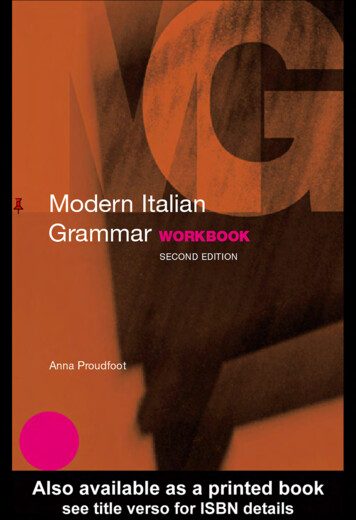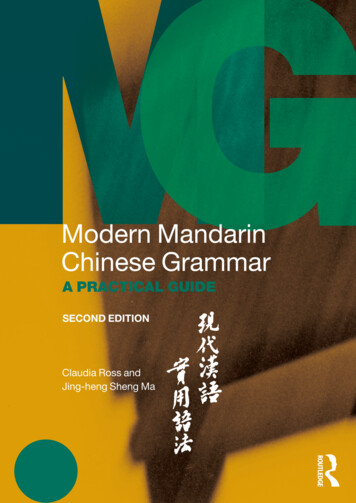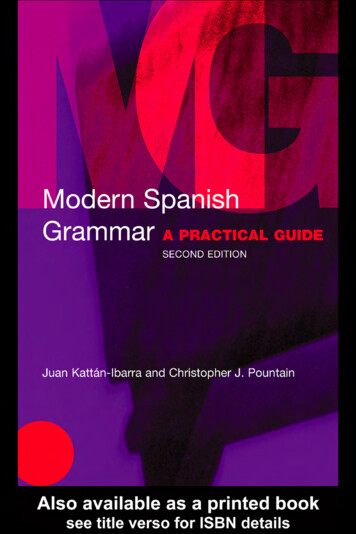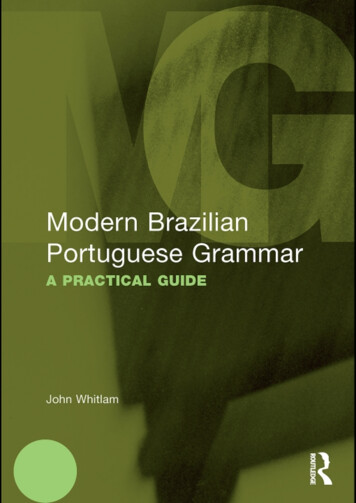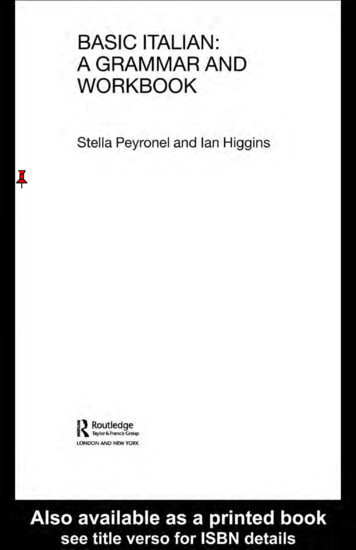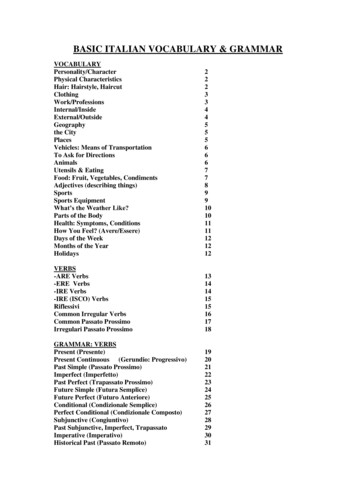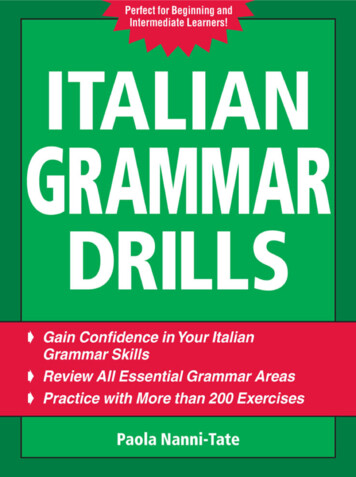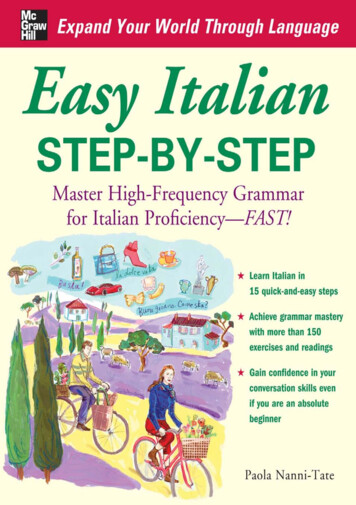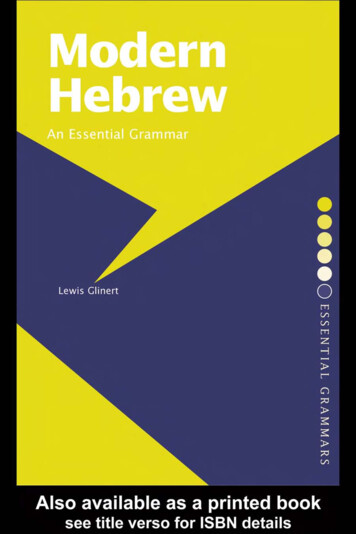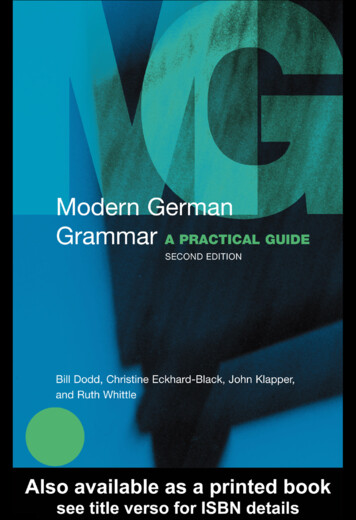
Transcription
6789401234567850123111ModernITALIANGrammarSecond Edition
Routledge Modern GrammarsSeries concept and development – Sarah ButlerOther books in series:Modern German Grammar, Second EditionModern German Grammar Workbook, Second EditionModern Spanish Grammar, Second EditionModern Spanish Grammar Workbook, Second EditionModern French Grammar, Second EditionModern French Grammar Workbook, Second Edition
6789401234567850123111ModernITALIANGrammarA practical guideSecond EditionAnna Proudfootand Francesco Cardo
First published 1997by RoutledgeSecond edition published 2005by Routledge2 Park Square, Milton Park, Abingdon, Oxon OX14 4RNSimultaneously published in the USA and Canadaby Routledge270 Madison Ave, New York, NY 10016This edition published in the Taylor & Francis e-Library, 2005.“To purchase your own copy of this or any of Taylor & Francis or Routledge’scollection of thousands of eBooks please go to www.eBookstore.tandf.co.uk.”Routledge is an imprint of the Taylor & Francis Group 1997, 2005 Anna Proudfoot and Francesco CardoAll rights reserved. No part of this book may be reprinted orreproduced or utilised in any form or by any electronic, mechanical,or other means, now known or hereafter invented, includingphotocopying and recording, or in any information storage orretrieval system, without permission in writing from the publishers.British Library Cataloguing in Publication DataA catalogue record for this book is available from the British LibraryLibrary of Congress Cataloging in Publication DataProudfoot, Anna.Modern Italian grammar: a practical guide/Anna Proudfoot andFrancesco Cardo. – 2nd ed.p. cm. – (Routledge modern grammars)Includes index.1. Italian language – Textbooks for foreign speakers – English.2. Italian language – Grammar. I. Cardo, Francesco, 1951–II. Title. III. Series.PC1129.E5P76 2005458.2′421 – dc222004026099ISBN 0–415–33483–7 (hbk)ISBN 0–415–33164–1 (pbk)
6789401234567850123111ContentsIntroductionHow to use this bookGlossaryPart AxiiixvxviiStructures1The noun group1.11.21.31.41.523General features of verbs 22Verb tables 31Moods and tenses of verbs 3965What is a pronoun? 65Personal pronouns 65Stressed personal pronouns 65Unstressed personal pronouns 67Relative pronouns 72Interrogative pronouns and adjectives 74Possessive pronouns and adjectives 75Demonstrative pronouns and adjectives 77Indefinite pronouns and adjectives .43.53.63.73.83.94What is a noun? 3The noun 3The article 10The adjective 14Agreement of noun, article and adjective 20Verbs2.12.22.33What is a preposition? 84Combined prepositions and articles 85Use of prepositions with nouns 85Use of prepositions with verbs 89Other prepositions 9184
CONTENTS5Conjunctions5.15.25.36798What is an adverb? 98Types of adverbs 98Comparative and superlative adverbs 101Numbers7.17.27.37.47.57.67.77.87.97.107.11Part BWhat is a conjunction? 93Coordinating conjunctions 93Subordinating conjunctions 95Adverbs6.16.26.393103What is a number? 103Cardinal numbers 103Ordinal numbers 104Calculations 106Percentages 106Collective and approximate numbers 106Dates 107Time 108Weights and measures 108Currency 109Table of numbers 109FunctionsIGiving and seeking factual information8Identification: giving personal information8.18.28.38.48.58.6910123Introduction 123Specifying a known or particular person or object 123Specifying category or type 124Specifying ownership 125Describing people or things10.110.210.310.410.510.610.7viIntroduction 115Tu or Lei? 115Giving different kinds of personal information 116Emphasising the person referred to 120Eliciting personal information 120Dialoghi 121Specifying people or objects9.19.29.39.4115Introduction 127Physical characteristics 127Non-physical attributes 130Intensifying the meaning of the adjective 133Diminishing the strength of the adjective 134Describing a physical state using stare 135Dialogo 136127
11112345678940123456785012311111Talking about existence, presence and availability13711.111.211.311.4Introduction 137Talking about existence and/or presence 138Talking about occurrence 139Talking about presence, attendance and participationat an event 14111.5 Talking about availability 14111.6 Expressing ‘some, any’ 14211.7 Specifying the quantity available 14411.8 Expressing ‘something, anything’, ‘someone, anyone’ 14511.9 Specifying location, time or frequency 14511.10 Expressing non-existence or non-availability 14612Talking about the present12.112.212.312.412.513Speaking/writing about the troduction 173Asking a question using interrogative intonation 173Asking a question using interrogative words 173Dialogo 176Negative sentences16.116.216.3167Introduction 167Using the future tense 167Using the present tense 167Expressing the immediate or very near future 168Expressing the English ‘going to’ 168The ‘past in the future’ 169The future seen from the past 169Some expressions of time in the future 170Expressing intention and future plans 172Asking questions15.115.215.315.4154Introduction 154The perfect aspect 155Using the passato prossimo 156Using the passato remoto 157Expressing the imperfect aspect 158Combinations of perfect and imperfect aspect 161Present tense expressing past 165Indicators of time 165Talking about the duction 149Describing present situations, actions and events 149Expressing ongoing actions 151Words and phrases indicating present time 151Dialogo 152Introduction 178Reinforcing a negative statement 178Expressing negation and time non . . . più, non . . . mai 179178
19.6II188Introduction 188Using a pronoun to refer back 188Using a pronoun: referring to the subject of an action 188Using a pronoun: referring to someone other thanthe subject 188Referring to someone or something using questo, quello 192Using indefinites to refer to ‘someone/something’ 192Referring to something or someone mentioned 193Referring to what has been said or will be said 193Focusing on the action19.119.219.319.4183Introduction 183Using comparative adjectives and adverbs 183Expressing ‘than’ 184Expressing ‘which’ 186Expressing different degrees of intensity 186Referring to objects and people18.118.218.318.419né . . . né 179niente, nulla 180the adjective nessun/o/a 180the pronoun nessuno/a 181Comparisons and degrees of intensity17.117.217.317.417.518Expressing negation usingExpressing negation usingExpressing negation usingExpressing negation usingReinforcing negation 181194Introduction 194Focusing on the action using the passive 194Situations when the passive is not used 197Focusing on the action using si passivante (passive formwith si) 199Si impersonale (impersonal si) 200Focusing on the object of the action 200Actions affecting ourselves and others20Social viiiGreeting, welcoming 203Introducing oneself and others 204Saying goodbye 205Wishes 206Expressing and receiving thanks, appreciation 206Compliments 207Making and accepting excuses, apologies 207Expressing commiseration, sympathy 208Using titles, salutations 208Getting other people to do things21.121.221.3203Introduction 211Giving orders and commands 211Making negative requests and commands 213211
21.922Permission and possibility22.122.222.322.423III225Need or want 225Expressing wants 225Expressing needs 227Suggesting, proposing, advising and recommending24.124.224.324.424.524.6221Asking or granting permission 221Denying permission 222Speaking about the ability or opportunity to do something 222Making a request 223Expressing need, obligation or desire23.123.223.324Written instructions and recipes 213Asking someone to do something 216Giving an order using ‘command’ verbs 217Far fare, lasciar fare construction 217Using persuasion 218Monologo 219229Giving advice 229Making or receiving a suggestion 230More expressions of advising or suggesting 232Advising someone not to do something, giving a warning 233Asking for advice 233Other ways of making suggestions 234Expressing emotions, feelings, attitudes and opinions25Expressing emotions: positive, negative, neutral25.125.225.325.425.525.62627ix253Expressing or seeking an opinion or belief 253Expressing agreement, disagreement 255Indicating preference, likes and dislikes28.128.2248Introduction 248Expressing hope 248Expressing fear, pessimism or regret 249Expressing doubt 251Expressing an opinion or belief, agreementor disagreement27.127.228Introduction 237Interjections (positive, negative, neutral) 237Expressing positive emotions 238Expressing negative emotions 241Expressing neutral emotions 245Expressing positive and/or negative emotions 247Expressing emotions: hope, fear, doubt26.126.226.326.4237Introduction 258Expressing likes 258258
CONTENTS28.328.429Expressing certainty and knowledge29.129.229.329.429.529.6IVExpressing dislikes 260Expressing a preference 262263Introduction 263Sapere 263Essere certo, sicuro, convinto 264Non certo, poco certo, incerto 265Pensare, credere, sembrare, parere 266Ricordare, dimenticare 266Putting in context30Combining tion 297Purpose involving only the subject of the action 297Purpose involving someone or something else 299Purpose attached to a person/object 300Expressing causes and tion 294Certainty, uncertainty 294Knowing, not knowing 295Possible or impossible, probable or improbable 295Evident, obvious 296Expressing purpose33.133.233.333.4287Introduction 287Quoting: direct speech 288Reporting: indirect speech 289Reporting information or quoting hearsay 291Expressing possibility and probability32.132.232.332.432.533Introduction 271Combining messages of equal importance 271Combining messages of unequal importance 274Setting events in a time context 274Relationship of main clause and dependent clauses 275Relationship of tenses in complex texts 279Quoting or reporting events and hearsay31.131.231.331.4271Introduction 302Specific people, factors or events responsible 302General cause or reason 302Il motivo, la causa, la ragione 305Causare, provocare, suscitare 306Dovere, dovuto 306Asking why 306Using the imperfect tense to give reasons 307302
11112345678940123456785012311135Expressing result, effect and ion 327Expressing a real possibility 327Expressing a condition unlikely to be met or impossible 328Expressing conditions with other conjunctions 329Expressing conditions with gerund, infinitive or participle 330Unfinished conditional sentence 331Other uses of se 332Expressing reservation, exception and concession39.139.239.3321Introduction 321Place: adverbs 321Place: prepositions 322Manner 324Expressing a condition or ion 313Expressing same time context 313Expressing earlier time context 314Expressing later time context 315Defining the limits of a period: ‘since’/‘until’ 317Specifying repetition and frequency 319Other expressions of time 320Place and manner37.137.237.337.438Introduction 308Coordinating conjunctions 308Conclusive (result) conjunctions 309Così, tale, tanto, troppo 310Words expressing result, effect 311Specifying time36.136.236.336.436.536.636.7308333Introduction 333Expressing reservation or exception 333Modifying a statement by concession 334Expanding the horizons40Registers and style40.140.240.340.440.540.640.741xiIntroduction 341Spoken and written discourse 341Differences in lexis 342Differences in syntax 343Informal written communication 346Formal and informal registers 347Word order 349Oral communication and telephone skills41.141.2341Introduction 352The Lei form 352352
CONTENTS41.341.441.541.641.741.842Written ns 354Discourse markers 354Techniques of oral communication 356Spelling on the telephone 357Telephone phrases 358On the telephone 360362Introduction 362Letters and faxes 362Curriculum vitae 365Extended writing: differences between English and Italian 367Writing essays, making connections 367Reports 367Bureaucratic language 371Scientific and technical language 372Journalistic language 373I:II:III:IV:Spelling and pronunciationIrregular verbsSequence of tensesVerbs and prepositions376381389390396
6789401234567850123111IntroductionModern Italian Grammar follows an entirely new approach to learning Italian. Itembraces a new way of looking at grammar – seeing it not as the ultimate goal, butas the tool with which we construct a dialogue or a piece of writing.Modern Italian Grammar is specifically designed to be accessible to the English readernot brought up in the Italian tradition of grammar and language analysis. It isunique both in its combination of the formal grammar reference section and theguide to usage organised along functional lines, and because it has been compiledby an English mother-tongue teacher of Italian and an Italian native speaker, workingclosely together.It is the ideal reference text to use with newer language courses, for both beginnersand advanced learners.The course books and textbooks published over the last two decades are based onthe principles of the communicative approach to language learning, which recognisesthat the objective of any language learner is to communicate, to get one’s messageacross, and that there can be many different ways of doing this, rather than a ‘right’way and a ‘wrong’
Modern Italian grammar: a practical guide/Anna Proudfoot and Francesco Cardo. – 2nd ed. p. cm. – (Routledge modern grammars) Includes index. 1. Italian language – Textbooks for foreign speakers – English. 2. Italian language – Grammar. I. Cardo, Francesco, 1951– II. Title. III. Series. PC1129.E5P76 2005 458.2′421 – dc22 2004026099 ISBN 0–415–33483–7 (hbk) ISBN 0–415 .
